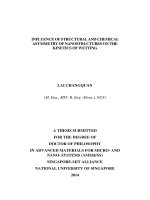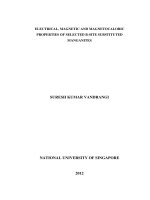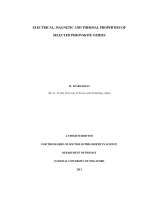Standardization, stability study and chemical properties of apricot jam prepared in cold Arid Region of Ladakh
Bạn đang xem bản rút gọn của tài liệu. Xem và tải ngay bản đầy đủ của tài liệu tại đây (143.4 KB, 5 trang )
Int.J.Curr.Microbiol.App.Sci (2019) 8(5): 495-499
International Journal of Current Microbiology and Applied Sciences
ISSN: 2319-7706 Volume 8 Number 05 (2019)
Journal homepage:
Original Research Article
/>
Standardization, Stability Study and Chemical Properties of Apricot Jam
Prepared in Cold Arid Region of Ladakh
Towseef A. Wani1*, Quraazah A. Amin2, S. Fauzia2, N. Dorjey1, B.A. Zargar1,
Phuntsog Tundup1, Kunzanglamo1, N. Deldan1, R. Safal1 and M.A. Beigh2
1
2
Krishi Vigyan Kendra Leh, SKUAST-K, J&K, India
Division of Food Science and Technology, SKUAST-K, J&K, India
*Corresponding author
ABSTRACT
Keywords
Apricot, Pectin,
Jam, TSS, Sugars
Article Info
Accepted:
07 April 2019
Available Online:
10 May 2019
This research was conducted to prepare apricot jam from the pulp of fresh mature apricots
by using artificial sweeteners .Apricots were washed with clean water to remove dust
particles. After sorting and pitting, apricots were cut into two halves and dipped in 0.1%
citric acid solution to avoid browning. The pulp of apricots was extracted by using
plumper. Apricot pulp was heated to get the desired consistency. Low heating was
continued and brix were noted after every 20 minutes. Pectin with small amount of nonnutritive sweeteners were dissolved separately and added to the mixture. Apricot jam can
be used for the lean period, as Ladakh remains cutoff from the whole world at least for six
months. The possibility of converting fresh apricots into jam has been investigated in this
study that showed a great promise in its manufacture. The samples were studied for their
chemical characteristics up to 90 days of storage. The parameters (i.e.), Titrable acidity,
pH, reducing sugar, Total sugar, TSS were determined in apricot jam. Physico-Chemically
the mean values of the results were 1.01, 3.52, 36.4, 53.64 and 68.00 respectively.
because it is one of the major sources of
livelihood. Almost every part of the fruit is
used by the local inhabitants; ripe apricot is
an excellent dessert fruit and is used for table
purposes having direct influence on the
upliftment of the farming community of the
region.
Introduction
Apricot (Prunus armeniaca L.) is the specie
of Prunus, which can be classified with the
Prunoidae subfamily Rosacea (Haydar et al.,
2007), is the most important fruit crop of
Ladakh. Its production is mostly confined to
the lower belt (double cropped area) of
Ladakh, where the climate is milder. The
lower belt includes areas from Saspol to
Batalik, Nubra valley and larger parts of
Kargil. The crop is intimately associated with
the culture and traditions of the region
Jam is the product that contains fruit pulp
from whole fruit or more kinds of fruit boiled
with sufficient quantity of sugars at low pH
(2.5-3.2) to produce a tissue with firm and gel
like consistency with or without addition of
495
Int.J.Curr.Microbiol.App.Sci (2019) 8(5): 495-499
water (Codex Ailamentarus, 2009). Pectin and
acids are added to obtain a good quality jam
with total solids and fruit accounting not less
than 65% and 45% respectively. Jams are
good carriers of fruit related components to
humans finding their way during early hours
on ones breakfast table. This fruit is pleasant
and having a charming aroma that’s why it is
consumed worldwide (Gutierrez et al., 2007).
Nutritionally, apricot is a rich source of
sugars, fibers, minerals, and vitamins
(thiamine, riboflavin, niacin and pantothenic
acid) (Sartaj et al., 2011). It also contains
considerable amounts of carotenoids (in the
form of b-carotene), and bioactive
phytochemicals like chlorogenic, caffeic, pcoumaric and ferulic acids (Dragovic et al.,
2007).
Blanching
Pitted apricot halves were blanched in citric
acid solution (0.1%) for two minutes to avoid
possible enzymatic reactions.
Pulp extraction
Fruit pulp was extracted with the help of
grinder/juicer by adding the apricot pieces in
pulp extracting machine.
Preparation of jam
Different ratios of sweeteners non caloric
were taken and used for jam preparation
according to the formula and procedure of
Awan and Rehman (1999). The jam samples
were cooked in the open steel container. The
fruit pulp were taken in an open container and
heated. At the same time commercial grade
pectin with small amount of non caloric
sweeteners were dissolved separately and
added to the mixture in container.
Preservatives and color was added at the end
of cooking.
The phenolics present in apricots mainly
include hydroxycinnamic and hydroxybenzoic
acids impart it with antioxidant properties
(Hussain et al., 2013). The study by Vardi et
al., (2013) showed the protective role of
apricots against the renal failure and
apoptosis. The annual production of apricots
in India is 18,000 tones limited to arid regions
of Ladakh, Kashmir and Himachal Pradesh,
contributing a negligible percentage of 0.45%
to the world’s production (Aina and Adesina,
1991).
Physico-chemical analysis
The prepared product was analyzed for Total
Soluble Solids, Acidity, pH, Reducing sugars
and Total sugars.
Materials and Methods
Titrable acidity and pH value
Fresh mature apricots were purchased from
Leh region of Ladakh and were transported in
wooden crates to the, Krishi Vigyan Kendra
Leh where the work was carried out.
The acidity as determined by titration
methods (Rangana, 1986) is a measure of
stability and shelf life of jam. The organic
acids present in fruits and those added during
making the jam manufacture contribute to the
acidity and thus decrease the pH. The pH was
measured by the standard procedures of
AOAC (AOAC, 2005). The sample prepared
for the pH determination involved weighing
of 25gm of the sample and dissolving it in
200ml of distilled water followed by boiling
Pre blanching operation
Apricots were washed with clean water to
remove dust and extraneous material. Then
after pitting apricots were cut into two haves
and were submerged in 1% citric acid
solution.
496
Int.J.Curr.Microbiol.App.Sci (2019) 8(5): 495-499
on a water bath for 1 hour. The solution was
cooled and diluted to 250ml with distilled
water, filtered and used for analysis. The pH
was determined by using a digital pH meter.
The titrable acidity was expressed as % citric
acid and calculated by the following formula:
% Titrable Acidity =
Titre x normality of alkali x vol. made x eq. weight of major acid x 100
Volume of sample taken for estimation x Wt. of sample taken x 1000
% Reducing Sugars =
Reducing sugars and total sugars
The reducing sugars were determined by Lane
and Enyon method (Rangana, 1986) which
determines the reducing sugars, expressed as
invert sugar that reduces the copper in
Fehling’s solution to red, insoluble cuprous
oxide. The procedure involves blending 50
gm of sample with 400 ml of water and
neutralizing it with 1N sodium hydroxide
using phenolphthalein indicator, followed by
gently boiling for about an hour and
maintaining its water level during the boiling.
The cooled solution is filtered and put into
500ml volumetric flask marking up the
volume and taking out 100ml aliquot added
with 200ml water and 2ml neutral lead acetate
solution, the excess of the later is precipitated
with potassium oxalate solution.
mg of invert sugar x dilution x 100
Titre x volume of sample x 100
% Total sugars are also calculated from the
above equation making use of titre value
obtained in the determination of total sugars.
Total soluble solids
Total soluble solids were determined by a
refractometer at room temperature and
applying the temperature correction to correct
the reading. The observed TSS as oB
determines percentage of the TSS in the jam.
Results and Discussion
The analyzed tritable acidity (%), pH,
reducing sugars (%), total sugars (%) and TSS
(Bo), of jam just after preparation and at an
interval of 0, 30, 60 and 90 days of storage
are presented in Table 1. The parameters
showed a notable change during the storage
period.
The sugar solution was titrated with 10 ml of
mixed Fehling solution and 50 ml water in a
250 ml flask to reduce almost completely the
Fehling’s solution. The flask was heated and
boiled for 15 seconds with persistence of blue
color indicating unreduced Fehling solution
and adding few more ml of sugar solution
until whole of the Fehling’s solution gets
reduced. The presence of faintest perceptible
blue color is the time for adding few drops of
methylene blue followed by adding sugar
solution until the indicator is completely
decolorized. The readings were recorded and
then employed used in the calculation of %
reducing sugars as:
Acidity and pH
The results pertaining to the titrable acidity
(Table 1) showed its increase during storage
from 1.01 % to 1.233%. The results correlated
with Hussain and Shakir (2010), for mixed
jam (apple and apricot) with different
formulations (Gowda et al., 2005). To obtain
optimum gel conditions of jam the pH is an
497
Int.J.Curr.Microbiol.App.Sci (2019) 8(5): 495-499
important factor and its estimation during
storage provides us the information whether it
was maintained or not during the entire study
for effective preservation. The values of pH
(Table 1) reveal its decrease due to the
formation of acidic compounds. The results
were similar with Ehsan et al., (2003).
sugar content of the jam during the storage
from 36.4 to 45.3% (Table 1). The same
results are shown by Vidhya and Narain
(2011). The inversion of sucrose into reducing
sugar (glucose and fructose) due to acid and
high temperature during storage results in its
increase. The increase can also be due to
prolonged storage and hydrolysis of sugars
with increase in acidity and decrease in pH..
The increase in total sugars from 53.64 to
57.02 resulted due to formation of sugars
from insoluble carbohydrates and starch. The
same increase in sugar is reported by Pota et
al., (1987) due to formation of sugars from
other complex carbohydrates. The Statistical
analysis revealed that the effect of storage on
total and reducing sugars of the jam is
significant (p≤0.05).
Total soluble solids (oBrix)
Total soluble solids showed a gradual
increase during storage period from 68 to 74
o
B. The solubilization of the jam constituents
may be the reason of its increase. Similar
results were reported by Hussain and Shakir
(2010).
Total sugars and reducing sugars (%)
There is a gradual increase in the reducing
Table.1 Storage effect on the chemical constituents of apricot jam
Parameters
0 day
30 days
60 days
90 days
Mean
Titrable acidity (%)
1.01
1.12
1.19
1.23
1.13
pH
3.52
3.43
3.32
3.24
3.37
Reducing sugars (%)
36.4
40.1
43.2
45.3
41.25
Total sugars (%)
53.64
55.51
56.15
57.02
55.58
TSS (0B)
68.00
70.00
72.00
74.00
71.00
In conclusion, the apricot-date as prepared
successfully remained acceptable for 90 days
after storage (DAS). There was a gradual
increase in all the observed parameters due to
hydrolysis or conversion of one compound
into other and maintaining a low pH
throughout the storage necessary for the
preservation process.
tropical fruits. Food Chemistry, 40:
345-351.
Awan, J., Salim UR (1999) Food Preservation
manual Uni-Tech. Comp. Faisalabad
Dragovic-Uzelac, V., Levaj B, Mrkic V,
Bursac D, Marija Boras M. 2007. The
content
of
polyphenols
and
carotenoids in three apricot cultivars
depending on stage of maturity and
geographical region. Food Chemistry
102, 966–975.
Ehsan, EB., Naeem ZP, Javed A and Nazir A
(2003). Development, standardization
References
Aina, J.O. and Adesina, A.A. (1991). Quality
attributes of jams from low usage
498
Int.J.Curr.Microbiol.App.Sci (2019) 8(5): 495-499
and storage studies on grape fruit
apple marmalade. Pakistan Journal of
Food Science, 13: 11-15
Gowda, A., Nallakurumban SM and
Kalaiselvan (2005). Studies on storage
stability of guava fruit bar indifferent
packaging materials. Beverage and
FoodWorld, 32: 80-81.
Gutierrez-Martinez, P., Schorr-Galindo, S,
Ragazzo-Sanchez,
J.A.
2007.
Discrimination of eight arieties of
apricot (Prunus armeniaca L) by
electronic nose, LLE and SPME using
GC–MS and multivariate analysis.
Sensors and Actuators B 125, 415–
421.
Haydar, H., Ibrahim, G., Mehmet, O.M.,
Bayram M. 2007. Post-harvest
chemical and physical mechanical
properties of some apricot varieties
cultivated in Turkey. Journal of Food
Engineering 79, 364-373.
Hussain, I., and Shakir, I. (2010). Chemical
and organolepticcharacteristics of jam
prepared from indigenous varieties of
apricot and apple. World Journal
ofDiary and Food Sciences, 5: 73-78.
Hussain, PR., Chatterjee S, Variyar PS,
Sharma A, Dar MA and Wani AM
(2013). Bioactive compounds and
antioxidant activity of gamma
irradiated sun dried apricots (Prunus
armeniaca L.). Journal of Food
Composition and Analysis, 30: 59-66.
Pota, SO., Ketsa, S. and Thongtham, M.L.
(1987). Effect ofpackaging material
and temperature on quality andstorage
life of pomegranate fruits. Journal
ofNatural Science, 23: 328-333
Rangana, S., (1986). Handbook of analysis
and qualitycontrol for fruit and
vegetable products. McGraw- Hill,
New Dehli.
Sarta,j A., Tariq M, Kashif Sarfraz A. 2011.
Physico-chemical characteristics of
apricot (Prunus armeniaca L.) grown
in northern areas of Pakistan. Scientia
Horticulturae 130, 386–392.
Vidhya, R., and Narain, A. (2011).
Development of preserved products
using under exploited fruits, Wood
Apple. American Journal of Food
Technology, 6: 279-288.
Vardi, N., Parlakpinar H, Ates B, Cetin A and
Otlu A (2013). The protective effects
of Prunus armeniaca L (apricot)
against
methotrexate-induced
oxidative damage and apoptosis in rat
kidney. Journal of Physiology and
Biochemistry, 69: 371-381.
How to cite this article:
Towseef A. Wani, Quraazah A. Amin, S. Fauzia, N. Dorjey, B.A. Zargar, Phuntsog Tundup,
Kunzanglamo, N. Deldan, R. Safal and Beigh, M.A. 2019. Standardization, Stability Study and
Chemical Properties of Apricot Jam Prepared in Cold Arid Region of Ladakh.
Int.J.Curr.Microbiol.App.Sci. 8(05): 495-499. doi: />
499









